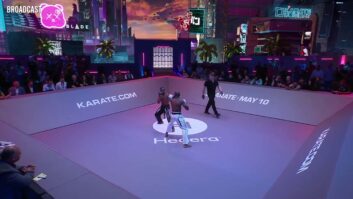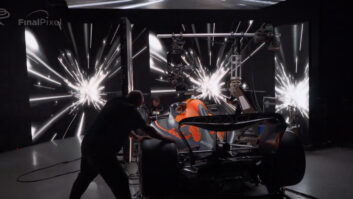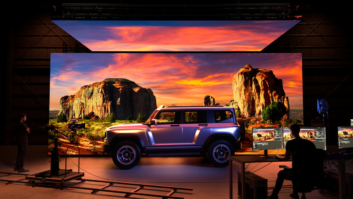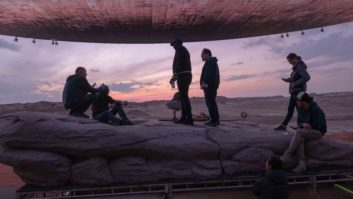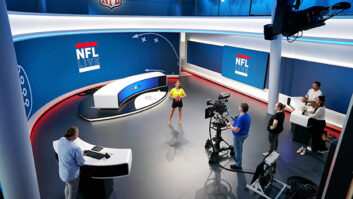The innovation of using virtual production techniques could make a significant impact in the race to net zero across broadcasters and production companies, with recent studies suggesting over a 90 per cent reduction in CO2 emissions.
However, I see it that VP needs to be considered as just one component of a suite of tools we can deploy to clean up our act on production.
For context, some of the numbers are staggering –
- In 2019, one hour’s worth of TV content produced 13 tonnes of carbon dioxide– with drama being the biggest culprit.
- While this reduced dramatically in 2020 due to lockdowns and restrictions on air travel, its clear from the albert 2020 report that people transport is consistently the highest emitter of carbon per hour of TV.
This article sums up where we are on this journey, and how using virtual production is not only likely to be a greener choice, but also acts as a vanguard to place the responsibility and discussions around sustainable production central to the project in hand.
7 ways to reduce your impact on the environment:
Complete a sustainability plan for your company, and champion it
Work to develop your overall company plan with a forward thinking and supportive team of environmental experts, like the consultants at Creative Zero or with Green Shoot. This will help cement the actions you want to take to become part of day to day life.
To help inform the plan, I really recommend getting training – it’s the first step for production and editorial teams on the journey and offered free of charge by albert.
We at Final Pixel have recently launched our own sustainability plan for this year.
Use virtual production to reduce travel costs
It’s clear the TV industry has a lot to do, but the data is emerging that’s beginning to show just how powerful choosing to use virtual production can be.
The use of LED walls and game engine technology to create in-camera VFX was pioneered on The Mandalorian, and has exploded as an industry since. Aside from the well documented benefits for both creatives and producers, it in increasingly being seen as a logical choice for companies looking to reduce emissions.
Anecdotal reports from a large international TV production business suggest if VP had been used to avoid travel or negated the need for a large scale set build, then the savings are potentially huge. A soon to be released snapshot analysis of an actual recent shoot, which replaced the need for an overseas second unit, showed a staggering reduction of over 95 per cent CO2 emissions.
Furthermore, a recent study overseen by Jeff Beverly of Commonwealth-McCann showed that for car shoots, the CO2 saving would also have been in the region of a huge 85%-90%. This could also be revolutionary for car manufacturers and advertising agencies seeking to reach net zero goals and lead the way in sustainability.
Measure measure measure – Use a calculator!
Everyone should be using albert by now to track emissions on TV productions.
There are many other forms of calculator available, some even come within a typical budgeting/scheduling template to make the whole process simpler for producers. A key point to note is that the calculators are not wholly consistent, so forging a path to a standard in calculating emissions makes a lot of sense to me.
A key factor in this calculator on our LED wall shoots is the power draw of the volume itself. What is exciting, is that we are hearing of more and more clever technology and software that can be deployed on virtual production shoots to actively manage the power draw – for example using AI to automatically dim the screen when it decides its not being used in anger. Technology that can be applied to all lighting sources in the studio – just because they are plugged in, doesn’t mean they need to burn 100 per cent the whole time!
Use virtual production to replace real world set builds with virtual environments
With virtual production using LED walls you can create any location in 3D. This is projected real-time onto the LED wall the parallax effect allows allows us to ‘look around corners’ when the camera moves.

At Final Pixel, our Virtual Art Department typically starts work 6-8 weeks ahead of a shoot. As a fully remote team we do not have the infrastructure emissions associated with commercial property and are able to be flexible when we need to scale up and down at short notice.
Importantly, building and filming on a virtual environment also brings what I call a recurring sustainability ‘dividend’ every time the virtual set is re-used – eg for a returning series or say for pickup shots. Once built, the energy which went into making it is complete and it can simply be pulled off the shelf for future productions. Cumulatively over time this could build to be a huge carbon reduction.
If you do need to use physical sets – make sure they are green sets.
Have a green steward on set.
This one is easy – hire a Green Steward on your next shoot.
The Green Steward will help ensure people are following best practices on set and act as a point of co-ordination, eg using reusable water bottles and saving plastic from recycling and landfill! They also manage the calculators.
You can read more about Green Stewards here.
Use real-time and virtual production to reduce the time in post
On shoots with a high degree of VFX – requiring compositing and lots of fancy rendering – you can reduce the impact of render farms and the additional emissions an elongated post schedule can bring by doing as much as possible in real-time.
Using the worlds most powerful content creation tool, Unreal Engine, we can ditch those renders and capture scenes live on-set on the LED wall. We leave the studio with Final Pixel shots – just like a location shoot.
Use a studio with the albert Studio Sustainability Standard 2022 accreditation
The basic goal is to find a studio powered by renewable energy. albert’s Creative Energy project is making it easier than ever for studios to sign up for renewable energy. Since LED uses a lot of energy- this is the simplest way to balance that usage. US studios are starting to answer the call as well.
The bigger the push/desire- the more will get on board.
So lets help drive it!
